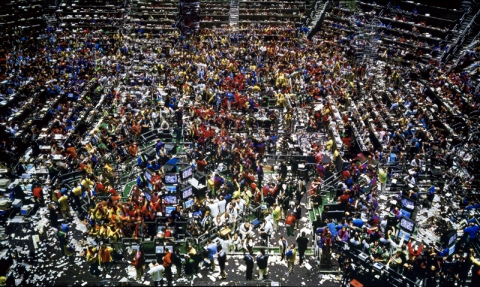Out Of The Pits: A Gursky Photograph and How to Represent Capital
December 20, 2012 § 2 Comments
A photograph of a frantic trading pit on an epic scale is installed on a gallery wall, its origins are the largest and oldest commodity exchange in the world. The photograph is titled Chicago Board of Trade II (1999) by German-born photographer, Andreas Gursky. Traversing the globe, Gursky makes images that reflect upon the human condition, as he sees it, manifest in urban, rural, cultural and industrial spaces. Although a former student of Bernd Becher (who worked professionally as an artist with his wife, Hilla Becher) at the Kunstakademie Düsseldorf (Düsseldorf Art Academy), Gursky has not completely subscribed to the dogma of strict objectivity, having always cropped and manipulated negatives when necessary and more recently, incorporated digital manipulation into his practice.
The Chicago Board of Trade is an exemplary site of modernity…in this location, everyday relationships to the potential of money and the necessity of trade become extreme. Financial professionals bring together flow, speed and technology in the pursuit of profits, and when thousands of them gather everyday, they help create something larger – the market.
Installed in a central passageway of London’s Tate Modern, the cultural anthropologist, Caitlin Zaloom, first encountered the image while in the city as part of her long-term ethnographic research on traders. The words quoted above form part of her response to the abstraction of capital that the image invokes, she continues:
a clear message about the velocity of money and its disordering effects in the global economy. The market takes in vast waves of capital and spews them out again in a logic all of its own. Yet the for the crowd of spectators around the photogaph, the commotion and dissarray are entrancing. It is unsettling to examine the picture closely, especially because a literal understanding of the physical space, or of the traders’ labor, is impossible. Instead it is easier to step back from the photograph and absorb the overall impression of the global financial beehive (2010: 2).
Her encounter with Gursky’s photograph forms the introduction to her book, Out of the Pits: Traders and Technology from Chicago to London (2010) and pivotally defines her methodological approach. While, understanding the functioning of such an aesthetic, Zaloom advocates as a priority to move beyond the abstraction of capital, as visually embodied in Gursky’s photograph – a function capital embraces also in the context of technological evolution regarding the labour of the traders themselves and their possible future abstraction – and a necessity, therefore, to look closer and in great detail at the apparatus of the global market:
Markets are objects of inquiry into the culture and economy of contemporary capitalism…today, the world’s powerful financial centers are the ones that need explanation. The mysteries of markets touch our lives, but few outside the financial profession understand them (2010: 11).
Duty and Distraction
June 20, 2012 § Leave a comment

Die Angestellten: Aus den neuesten Deutschland/The Salaried Masses: Duty and Distraction in Weimar Germany by Siegfried Kracauer (front cover, Verso edition, 1998)
Published in 1930, Die Angestellten: Aus den neuesten Deutschland/ The Salaried Masses: Duty and Distraction in Weimar Germany by the writer and theorist, Siegfried Kracauer, was critically acclaimed. His friend and fellow author, Walter Benjamin, wrote, ‘ the entire book is an attempt to grapple with a piece of everyday reality, constructed here and experienced now. Reality is pressed so closely that it is compelled to declare its colors and name names’. Kracauer sought to address the new class of salaried employees of the Weimar Republic:
Spiritually homeless, divorced from all custom and tradition, these white-collar workers sought refuge in entertainment—or the “distraction industries,” as Kracauer put it—but, only three years later, were to flee into the arms of Adolf Hitler. Eschewing the instruments of traditional sociological scholarship, but without collapsing into mere journalistic reportage, Kracauer explores the contradictions of this caste. Drawing on conversations, newspapers, adverts and personal correspondence, he charts the bland horror of the everyday. In the process he succeeds in writing not just a prescient account of the declining days of the Weimar Republic, but also a path-breaking exercise in the sociology of culture which has sharp relevance for today.
Informed by sociology and discourse of the cinema, the publication was innovative both methodologically, for what could be described as its anticipated ‘ethnographicness’ and the resulting representational strategies of the ‘montage principle’. Kracauer employed a hybrid-like approach including ‘quotation, conversation, report, narrative, scene, image’ and as Inka Muelder-Bach, in her introduction to the English edition, observes:
His investigation…refrains from formulating its insight in a conceptual language removed form its material. Instead, Kracauer seeks to construct in that material. In other words, knowledge of the material’s significance becomes the principle of its textual representation, so that the representation itself articulates the theory.
The significance of its representational structure as means to articulate the everyday of ‘salaried employees’ material living conditions and that of the ideologies superimposed on this reality’ make it a important publication of continuing critical resonance.




